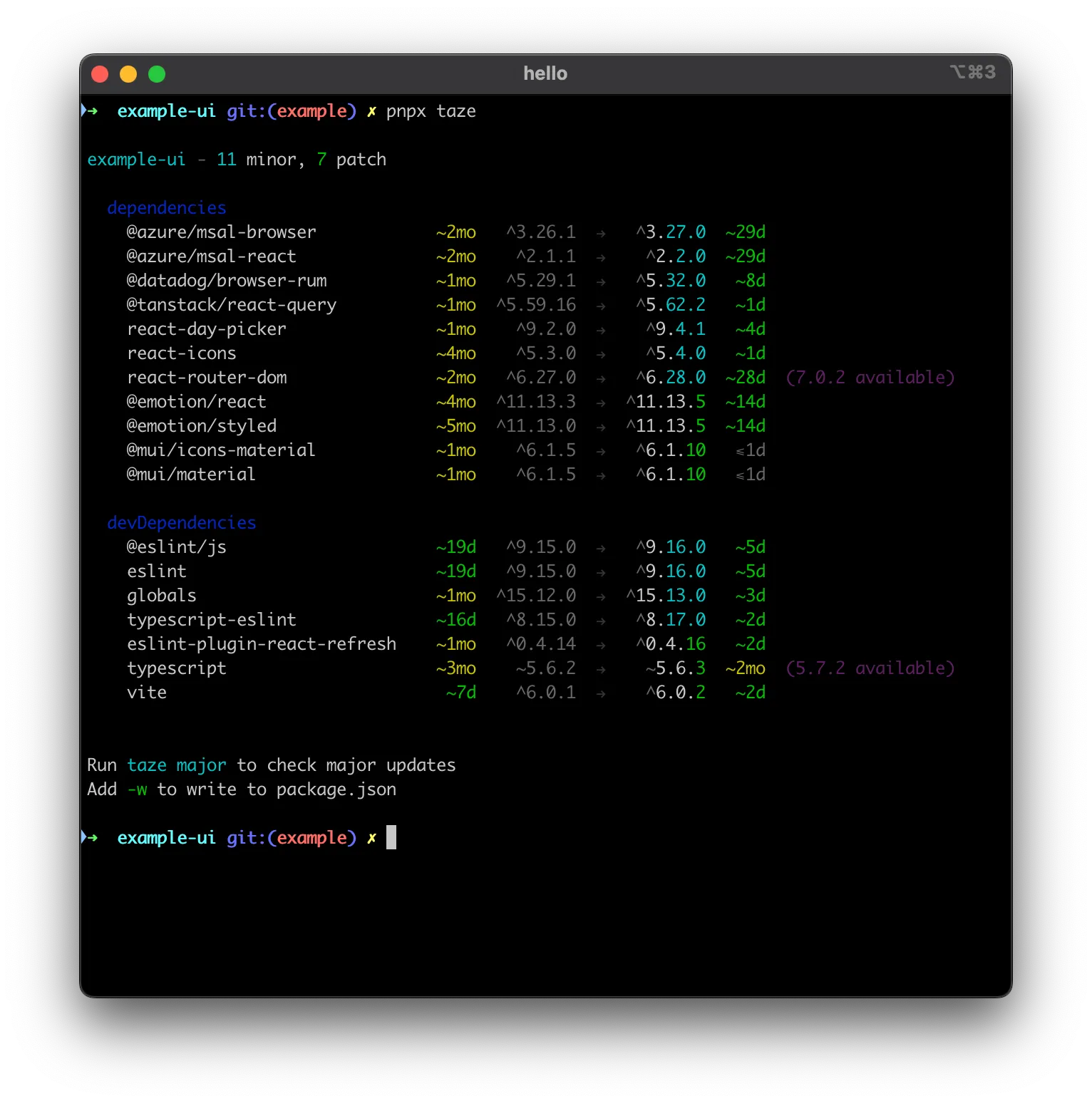I like using ncu, see my original npm-check-updates post and ncu-skip-pinned-versions post. Despite that, I still look out for alternative tooling that might perform better.
Here’s one such tool: taze.
(/ta:zei/, fresh in Persian) A modern cli tool that keeps your deps fresh
At a high level, here’s what I like about taze:
- suitably runnable through pnpx (npx)
- ⭐️ no global installation necessary
- reasonable defaults
- ⭐️ respects existing package.json version ranges, but also softly informs of major upgrades if available
- readable out of the box
- ⭐️ aligned columns
- dry run first
- uses a
-wflag to confirm rewriting thepackage.jsonfile
- uses a
Aside from that, all it does is rewrite the package.json accordingly.
Here’s the output for a reasonably maintained codebase. (The weight of the ecosystem churn is heavy, isn’t it?)
Using taze:

➜ example-ui git:(example) ✗ pnpx taze
example-ui - 11 minor, 7 patch
dependencies
@azure/msal-browser ~2mo ^3.26.1 → ^3.27.0 ~29d
@azure/msal-react ~2mo ^2.1.1 → ^2.2.0 ~29d
@datadog/browser-rum ~1mo ^5.29.1 → ^5.32.0 ~8d
@tanstack/react-query ~1mo ^5.59.16 → ^5.62.2 ~1d
react-day-picker ~1mo ^9.2.0 → ^9.4.1 ~4d
react-icons ~4mo ^5.3.0 → ^5.4.0 ~1d
react-router-dom ~2mo ^6.27.0 → ^6.28.0 ~28d (7.0.2 available)
@emotion/react ~4mo ^11.13.3 → ^11.13.5 ~14d
@emotion/styled ~5mo ^11.13.0 → ^11.13.5 ~14d
@mui/icons-material ~1mo ^6.1.5 → ^6.1.10 ⩽1d
@mui/material ~1mo ^6.1.5 → ^6.1.10 ⩽1d
devDependencies
@eslint/js ~19d ^9.15.0 → ^9.16.0 ~5d
eslint ~19d ^9.15.0 → ^9.16.0 ~5d
globals ~1mo ^15.12.0 → ^15.13.0 ~3d
typescript-eslint ~16d ^8.15.0 → ^8.17.0 ~2d
eslint-plugin-react-refresh ~1mo ^0.4.14 → ^0.4.16 ~2d
typescript ~3mo ~5.6.2 → ~5.6.3 ~2mo (5.7.2 available)
vite ~7d ^6.0.1 → ^6.0.2 ~2d
Run taze major to check major updates
Add -w to write to package.json
Here’s the same codebase with scanned with ncu:

➜ example-ui git:(example) ✗ ncu --format group
Using pnpm
Checking /Users/ryan/Code/ryan/example-ui/package.json
[====================] 36/36 100%
Patch Backwards-compatible bug fixes
@emotion/react ^11.13.3 → ^11.13.5
@emotion/styled ^11.13.0 → ^11.13.5
@mui/icons-material ^6.1.5 → ^6.1.10
@mui/material ^6.1.5 → ^6.1.10
vite ^6.0.1 → ^6.0.2
Minor Backwards-compatible features
@azure/msal-browser ^3.26.1 → ^3.27.0
@azure/msal-react ^2.1.1 → ^2.2.0
@datadog/browser-rum ^5.29.1 → ^5.32.0
@eslint/js ^9.15.0 → ^9.16.0
@tanstack/react-query ^5.59.16 → ^5.62.2
eslint ^9.15.0 → ^9.16.0
globals ^15.12.0 → ^15.13.0
prettier 3.3.3 → 3.4.2
react-day-picker ^9.2.0 → ^9.4.1
react-icons ^5.3.0 → ^5.4.0
typescript ~5.6.2 → ~5.7.2
typescript-eslint ^8.15.0 → ^8.17.0
Major Potentially breaking API changes
@typescript-eslint/eslint-plugin ^7.18.0 → ^8.17.0
@typescript-eslint/parser ^7.18.0 → ^8.17.0
date-fns ^3.6.0 → ^4.1.0
react-router-dom ^6.27.0 → ^7.0.2
Major version zero Anything may change
eslint-plugin-react-refresh ^0.4.14 → ^0.4.16
Run ncu --format group -u to upgrade package.json
The output between taze and ncu shows similar data, but with distinct flavors. The patch/minor/major break down of ncu is informative, but at the same time annoying because upgrading majors is much less a maintenance task, and not really a useful default. The dependencies vs devDependencies break down of taze is useful (build time dependencies are less of a security risk in most cases). The relative dates for “how old the existing version is” and “how young the new version is” are useful gauges for churn and prioritization.
These days, I am trialing taze as a primary dependency update tool. I still occasionally use ncu just to double check though. There’s no real loss in using both for now, and if you decide one is better than the other, that’s fine too.
Follow me on Mastodon @ryanmr@mastodon.cloud.
Follow me on Twitter @ryanmr.